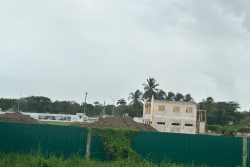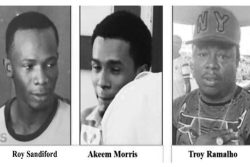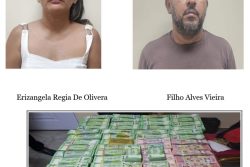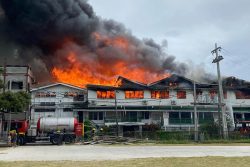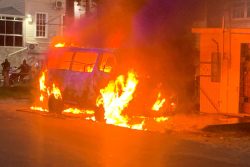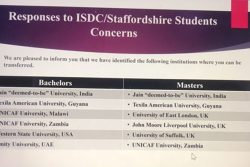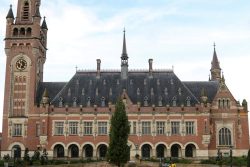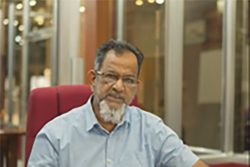 The local saying, “What don’t kill does fatten,” clicked recently. This aptly describes enduring and succeeding despite challenging circumstances. I am thinking about how tough one has to be to endeavour the arts as a principal livelihood in places like Guyana with minimal enabling structures and systems for artists, artistes, and creatives to tap into. And it seems there is always a critic. Fair enough, I suppose. After all, we are all entitled to our opinion. Too often the critics have minimal or no qualifying background but confidence in their assertions and perhaps even position to pronounce on things. Insufficiently informed critics with platforms make a frightful combination, which is not surprising. There is minimal arts education – a lot of STEM but not enough STEAM.
The local saying, “What don’t kill does fatten,” clicked recently. This aptly describes enduring and succeeding despite challenging circumstances. I am thinking about how tough one has to be to endeavour the arts as a principal livelihood in places like Guyana with minimal enabling structures and systems for artists, artistes, and creatives to tap into. And it seems there is always a critic. Fair enough, I suppose. After all, we are all entitled to our opinion. Too often the critics have minimal or no qualifying background but confidence in their assertions and perhaps even position to pronounce on things. Insufficiently informed critics with platforms make a frightful combination, which is not surprising. There is minimal arts education – a lot of STEM but not enough STEAM.
Visual artists have it particularly tough in Guyana. Why? Because everyone knows something about visual art, and most seem to think the little they know gives them full authority. Maddening. I have studied and practised this art thing all my adult life, but I do not consider myself an authority. Far from it. The more I learn the more there is to learn. There is so much to learn! But I can assure you I have encountered my fair share of folks who have studied less, committed far less of their time thinking about or producing art and they are authorities. Authorities with platforms. Sometimes, we who studied this art thing formally, acquiring diplomas and degrees, are silenced by those who dabbled, perhaps in high school or university or have a friend or colleague who is an artist. I wonder about dialogues with artists and when we will be assumed to have the intelligence to speak for ourselves and have a valid word-based opinion. Seems our opinions are only valid when painted or carved or stamped on fabric or some such. And these opinions presented in the visual format are only valid when they satisfy the remit of art as defined by the ‘authorities’.
I am weary of announcements of support for visual artists. Why? Whenever we are called upon, it feels like a show of inclusion. Does anyone really care what we have to say? It does not seem so. When we are called upon for exhibitions these often feel last minute and hodge podge. In local lingo: meche meche – some ah dis and some ah duh. No cohesion of thought in the work presented. Instead, a display of diverse thoughts, concerns, and approaches with no robust curatorial direction. These are really exhibitions to show that the creative impulse survives. Of course, it does. And it always will. The creative impulse has always been here. Speak to the archaeologist of prehistory and s/he can tell you of the ingenuity demonstrated by prehistoric humans in developing their tool technology. Things we take for granted like clothes, vehicles of transport, and built shelters were innovations of prehistoric humans thousands of millennia ago, developed into what we have today. The creative impulse made this possible. A defining characteristic of the human collective is our evolving creative impulse. When it dies, we will cease to be human. Creative thought, creative action, and creative expression define us as a human collective.
Perhaps, I digress. I suppose these exhibitions of the survival of the creative impulse are all we can hope for at the moment. Guyana is mineral rich but we – its people – are not rich. The big concrete edifices on main roads and the large SUVs on Sunday afternoon drives suggest a tale. We are not rich. We do not invest in nurturing the soul. We are still concerned with the body. Survival. Chakra 1. Roofs over our heads, food on our tables, and the material trappings of success; of development. We are focused on the needs of the self, the family, and the (political) tribe. When we get those sorted en masse perhaps we will start to think about the soul and the non-material needs of the body. This is the value of the arts for me. Done well, done with integrity, the arts meet us at this foundational space. Without the soul enlivened, there is no living. There is banal existence. Yet it is deprived. Religion and spirituality are ways of satisfying it. But they are not the only way and not everyone’s cup of tea. Engagement with the arts can satisfy this need.
Years ago, the Indian High Commission (I think) brought a Kathak dance performance to the National Cultural Centre. The show was beautiful. I do not mean only optically, although it was. One dance stuck with me. Perhaps it was the energies transmitted through the drums coupled with the dancer tapping out her responses. It was magical. Transcendental. A moment of peace wrapped in rhythm.
Sometime back the US Embassy brought jazz to the National Cultural Centre. Another beautiful evening. An initiative to mark Black History Month. Then there was Jazz in the Rainforest, a week-long multi-venue production of the proprietors of the Sidewalk Jazz Café. World Cup Cricket was the season. I have lingering memories of savouring the sounds of jazz along the Upper Demerara River, on the lawns of a hotel now abandoned. Sometime later, there was Jazz at the Promenade Gardens. So much beauty is available to us. The sweet sounds of pan and a rare gem – the tassa drummers from Annandale and the African drummers from Buxton harmoniously speaking, holding one accord in rhythm. But we are subsumed in vulgarity and crassness parading as music (and dance). The assault is inescapable. Morning, day and night. Sounds travel and it seems the greater the vulgarity of the lyrics, the louder the music gets played out of cars, minibuses, shops, and homes. I worry about what children are hearing in the guise of music travelling to their ears on the northeast trade winds. I worry and I get angry. I am angry for myself, too. I have ways of tuning it out. See, I am careful about what I feed my soul but feed it well I must, lest I solely exist losing the pleasures of living.
Akima McPherson is a multimedia artist, art historian, and educator
